Kayaking is a water sport in which the player paddles a kayak with a double-bladed paddle. The kayak moves either directly forward or sideways, and the direction of travel is controlled by turning the paddle left or right. Kayaks are used for recreation, racing, touring, and fishing.
Kayaking became popular in the 1950s and has since become one of the most popular water sports in the world. According to a 2012 report by the Outdoor Industry Association, kayaking is the fastest-growing outdoor recreation activity in the United States, with more than 10 million people participating each year.
There are many different types of kayaks, and they are classified by their purpose, design, and construction. Recreational kayaks are the most popular type, and they are designed for use in calm waters such as lakes and rivers.
Touring kayaks are designed for longer trips on open waters, and they often have more storage space than recreational kayaks.
Racing kayaks are designed for speed and maneuverability, and they are often used in competitions.
Fishing kayaks are designed for anglers, and they often have features such as rod holders and livewells.
Kayaks are usually made from plastic, fiberglass, or composite materials. The most popular type of kayak is the plastic kayak, which is durable and easy to care for.
Table of Contents
Why Do People Love to Go Kayaking?
The answer is simple – because it’s fun! Kayaking is a great way to enjoy the outdoors, get some exercise, and spend time with friends and family. It’s also a relatively easy sport to learn, and you don’t need a lot of expensive gear to get started.
If you’re still not convinced, here are 10 more reasons why you should go kayaking:
- Kayaking is a great way to get some exercise.
- Kayaking is a great way to relax and de-stress.
- Kayaking is a great way to enjoy the outdoors.
- Kayaking is a great way to see new places.
- Kayaking is a great way to get away from it all.
- Kayaking is a great way to spend time with friends and family.
- Kayaking is a great way to meet new people.
- Kayaking is a great way to learn new skills.
- Kayaking is a great way to challenge yourself.
- Kayaking is a great way to have fun!
What Do You Need to Go Kayaking?
The good news is that you don’t need a lot of gear to go kayaking. In fact, all you really need is a kayak, a paddle, and a life jacket (also called a PFD or personal floatation device). Of course, there are many other kayaking accessories available, but these are the only essential items.
If you’re renting a kayak, you may be able to get away with just renting a paddle and PFD, but it’s always a good idea to bring your own if you have them. That way, you can be sure that the paddle is the right length for you, and that the PFD fits properly.
In addition to a kayak, paddle, and PFD, you should also bring some sunscreen, insect repellent, a hat, water, snacks, and a first-aid kit. And if you’re going to be kayaking in cold water, you’ll need to dress appropriately in layers to stay warm.
Before You Go Kayaking
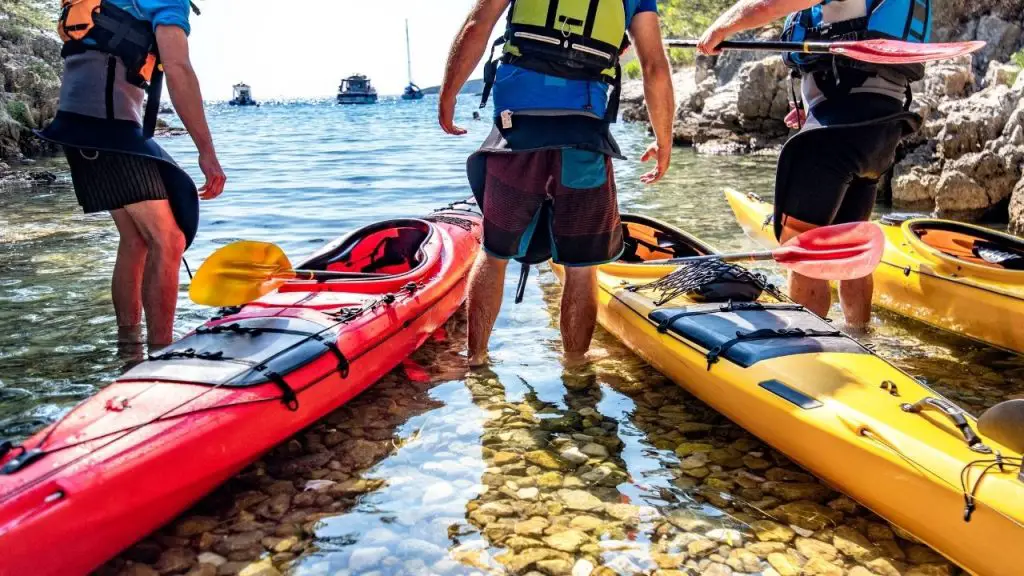
If you’re new to kayaking, there are a few things you should do before your first trip. First, take some time to learn the basics of kayaking. There are many good resources available, including books, websites, and classes offered by local recreation departments or kayak clubs.
Second, practice paddling in a pool or calm water before you go out on open water. This will help you get comfortable with the paddle and the kayak, and it will give you a chance to try out different strokes.
Finally, make sure you have all the gear you need, and that it fits properly. Nothing ruins a day on the water like ill-fitting gear, so take the time to get it right before you go.
Kayak Basic Knowledge
Unless you are a experienced kayaker, you will likely find yourself in situations where your lack of knowledge or skill could put you at risk. Learning the basics of kayaking can help reduce these risks and make your time on the water more enjoyable.
How to Get In and Out of A Kayak

Wet exits are the most important thing to learn when kayaking. This is how you get out of the kayak if it capsizes, and you’re upside down in the water. It’s not as difficult as it sounds, but it’s very important to know how to do this in case of an emergency.
To do a wet exit, first, reach behind you and grab the back of the cockpit. You may have to feel around for it if you’re upside down in the water. Then, swing your legs out of the kayak and push off with your feet. The kayak will come off of you and float away.
Once you’re out of the kayak, swim to the shore or to a nearby boat. Do not try to get back into the kayak from the water. It’s very difficult to do and is not necessary.
If you’re having trouble getting out of the kayak, there are a few things you can do. First, try to relax. It’s hard to do when you’re upside down in the water, but it will make it easier to get out. Second, use your hands to push off of the kayak. This will help you swing your legs out. Finally, if you’re still having trouble, there is a rescue handle on the back of most kayaks. This is a rope that you can grab onto to help pull yourself out.
Now that you know how to get out of the kayak, it’s time to learn how to get back in. This is called a self-rescue and is also very important. To do a self-rescue, first, flip the kayak over so that it’s right-side up. Then, get into the water next to the kayak and grab onto the side.
- You may have to push down on the kayak with your hands to get your legs over.
- Put one leg into the cockpit
- Swing your other leg over.
- Once you’re in, sit up and make sure that you’re strapped in.
That’s it!
You’ve now learned the basics of getting in and out of the kayak.
Remember, wet exits are very important to know how to do in case of an emergency. And, self-rescues are also important so that you can get back into the kayak if it capsizes.
Kayak Paddling Techniques
The Forward Stroke
The forward stroke is the most basic kayak paddling technique.
To do a forward stroke, first, reach your paddle out in front of you and put it into the water. Then, start pulling the paddle towards you, using your arms and shoulders.
As you pull the paddle towards you, twist your torso so that your hips and shoulders are facing the direction you want to go.
The forward stroke is the most important kayak paddling technique to learn because it’s the one you’ll use most often. However, there are a few other strokes that you should also know.
The back stroke
The back stroke is used to slow down or stop the kayak.
To do a back stroke, reach your paddle behind you and put it into the water. Then, start pulling the paddle towards you, using your arms and shoulders.
As you pull the paddle towards you, twist your torso so that your hips and shoulders are facing the direction you want to go.
The back stroke can also be used to turn the kayak.

To turn the kayak using a back stroke, reach your paddle behind you and put it into the water on the side you want to turn towards. Then, start pulling the paddle towards you, using your arms and shoulders. As you pull the paddle towards you, twist your torso so that your hips and shoulders are facing the direction you want to go.
The back stroke is a very important kayak paddling technique to learn because it can be used in case of an emergency.
If you find yourself capsized and upside down in the water, you can use a back stroke to turn the kayak right-side up and get back into it.
The Sweep Stroke
The sweep stroke is used to turn the kayak.
To do a sweep stroke, reach your paddle out in front of you and put it into the water on the side you want to turn towards. Then, start sweeping the paddle in a wide arc towards the back of the kayak.
As you sweep the paddle, twist your torso so that your hips and shoulders are facing the direction you want to go.
The sweep stroke is a very important kayak paddling technique to learn because it can be used in case of an emergency. If you find yourself capsized and upside down in the water, you can use a sweep stroke to turn the kayak right-side up and get back into it besides the back stroke.
Other techniques
There are many other kayak paddling techniques that you can learn. However, these are the most basic and essential strokes that you need to know.
Practice these strokes often so that you can master them and be prepared for anything while out on the water.
How to Capsize and Rescue Yourself

Capsizing is when the kayak flips over and you end up in the water. It can happen due to waves, wind, or other factors beyond your control. If you find yourself capsized and upside down in the water, don’t panic! There are a few things you can do to rescue yourself.
First, try to stay calm and assess the situation. If you’re able to reach the kayak, try to grab it and flip it back over. If you can’t reach the kayak, or if it’s too heavy to flip by yourself, don’t worry! There are a few other things you can do.

One option is to swim to the shore and find a way to flip the kayak over there.
Another option is to grab hold of the kayak and wait for someone to come and help you flip it over.
If you’re unable to flip the kayak over, or if you’re unable to reach the shore, don’t worry! There are a few other things you can do.
One option is to grab hold of the kayak and wait for someone to come and help you flip it over.
Another option is to use your paddle to push the kayak towards the shore.
Remember: capsizing can happen to anyone at any time. The most important thing to do is to stay calm and think about the best way to rescue yourself. With a little practice, you’ll be able to capsized and get back into your kayak like a pro!
How to Identify Your Paddle Blades
There are two types of paddle blades: symmetrical and asymmetrical. Symmetrical paddle blades are the same on both sides, while asymmetrical paddle blades are different on each side.
1. To identify your paddle blade type, look at the blade from the top. If the blade is symmetrical, it will be the same on both sides. If the blade is asymmetrical, it will be different on each side.
2. To identify your paddle blade type, look at the blade from the bottom. If the blade is symmetrical, it will be the same on both sides. If the blade is asymmetrical, it will be different on each side.
3. If you’re still not sure which type of paddle blade you have, ask a friend or family member to help you identify it. Once you know which type of paddle blade you have, you can start using it to paddle your kayak!
Other Beginner Kayak Tips and Techniques
Next, let’s talk about some other beginner kayak tips and techniques. If you’re just getting started in kayaking, there are a few things you should keep in mind.
First of all, it’s important to always wear a life jacket. Kayaks can tip over easily and if you’re not wearing a life jacket, you could drown.

Secondly, it’s important to learn how to paddle correctly. If you don’t paddle correctly, you won’t be able to move the kayak in a straight line and you’ll quickly get tired. To practice paddling, try paddling in a straight line for a distance of 100 yards. Then, turn around and paddle back to where you started.
It’s important to know how to rescue yourself if you tip over. If you’re kayaking with someone else, they can help you get back into your kayak. But if you’re alone, you need to know how to get back into your kayak by yourself.
If you are not a pro, don’t kayak with children. If you are, be aware that children can drown easily so never let them out of your sight.
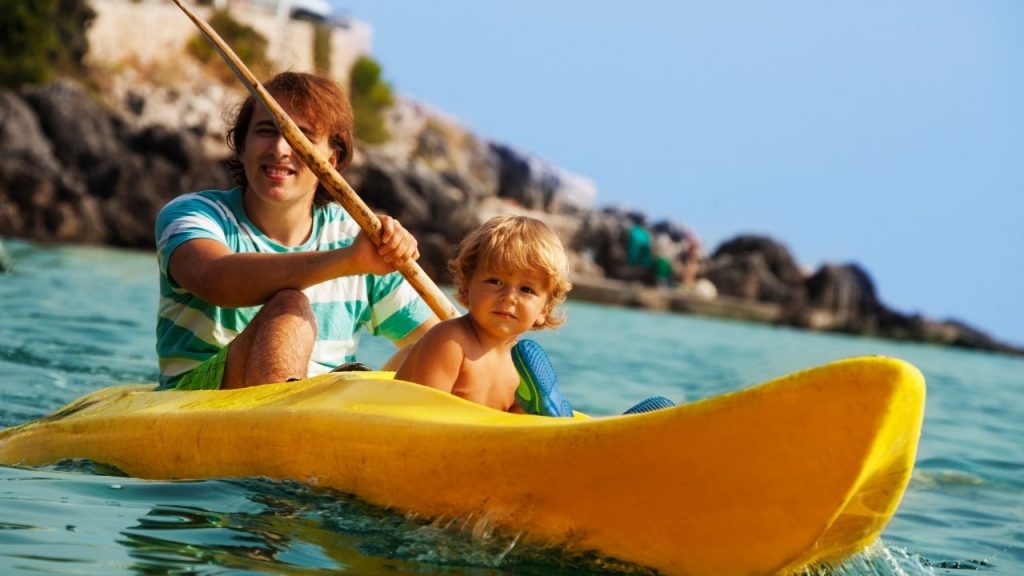
Try to plan a short kayak trip with a friend or family member before going on a longer trip. This will give you a chance to practice your skills and get comfortable with kayaking.
Finally, always be aware of your surroundings when you’re kayaking. Keep an eye out for rocks, other boats, and other hazards. If you see something that could be dangerous, paddle away from it.
Kayaking is a great way to enjoy the outdoors and get some exercise. By following these beginner kayak tips, you’ll be sure to have a safe and fun time kayaking.
Weather Conditions Check
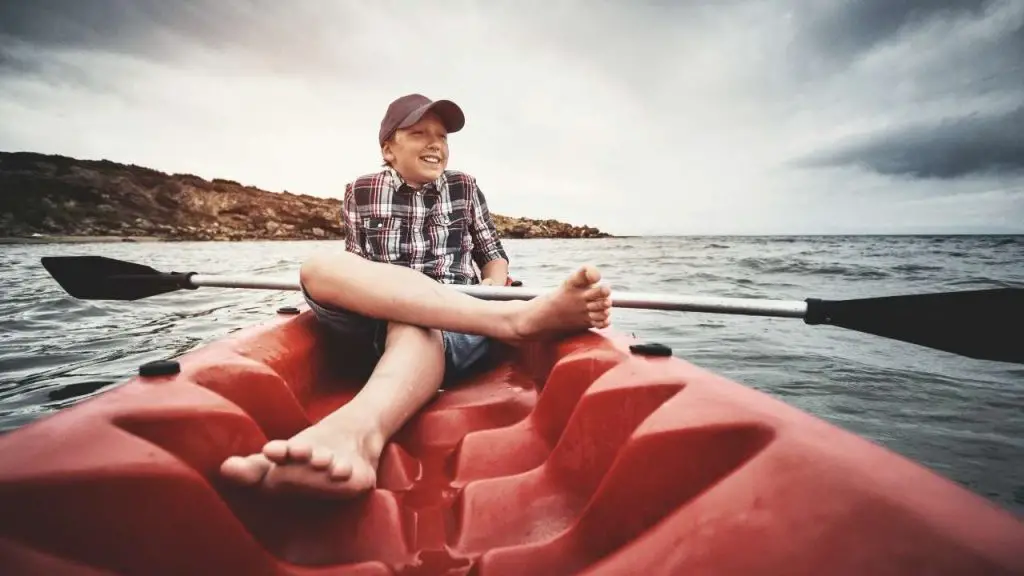
When it comes to kayaking, there is no such thing as “bad” weather, only bad preparation. That being said, there are some weather conditions that are better suited for kayaking than others. Here is a breakdown of the best (and worst) weather conditions for kayaking:
The Best Weather Conditions for Kayaking:
Warm temperatures: Kayaking is a great way to cool off on a hot day. Just be sure to apply sunscreen and drink plenty of water to stay hydrated.
Light winds: A little breeze can actually be helpful when kayaking, as it can help keep you cool. However, strong winds can create waves and currents that make kayaking more difficult and even dangerous.
Calm waters: Obviously, choppy waters are not ideal for kayaking. Smooth, calm waters are best, as they make maneuvering your kayak much easier.
The Worst Weather Conditions for Kayaking:
Extreme cold: Kayaking in cold weather can be very dangerous, as you could easily develop hypothermia. If you do decide to go kayaking in cold weather, be sure to dress warmly and pack extra blankets and clothes in case you get wet.
High winds: As mentioned above, high winds can create waves and currents that make kayaking more difficult and even dangerous. If you must go out in high winds, be sure to stay close to shore and avoid areas with large waves.
Rough waters: Choppy, rough waters are obviously not ideal for kayaking. If you must go out in rough waters, be sure to wear a life jacket and stay close to shore. Also, be aware of your surroundings and watch out for large waves.
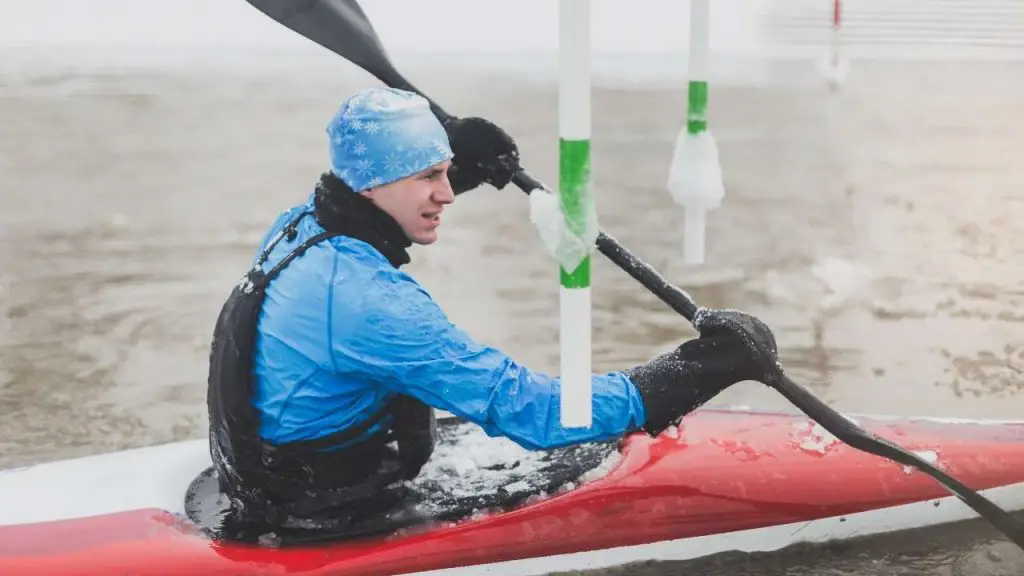
You might want to explore the strong feeling but as a beginner, you should not kayak in bad weather because it can be dangerous.
Strong winds can create waves and currents that make kayaking more difficult and even dangerous.
Choppy, rough waters are also obviously not ideal for kayaking, and can pose a serious danger to beginners.
If you want go out in bad weather, be sure to stay close to shore and avoid areas with large waves. Also, be sure to wear a life jacket and dress warmly if it is cold outside. But importantly, our safety rule for beginners: Do not kayak in bad weather.
What to Do When Weather Suddens Change?
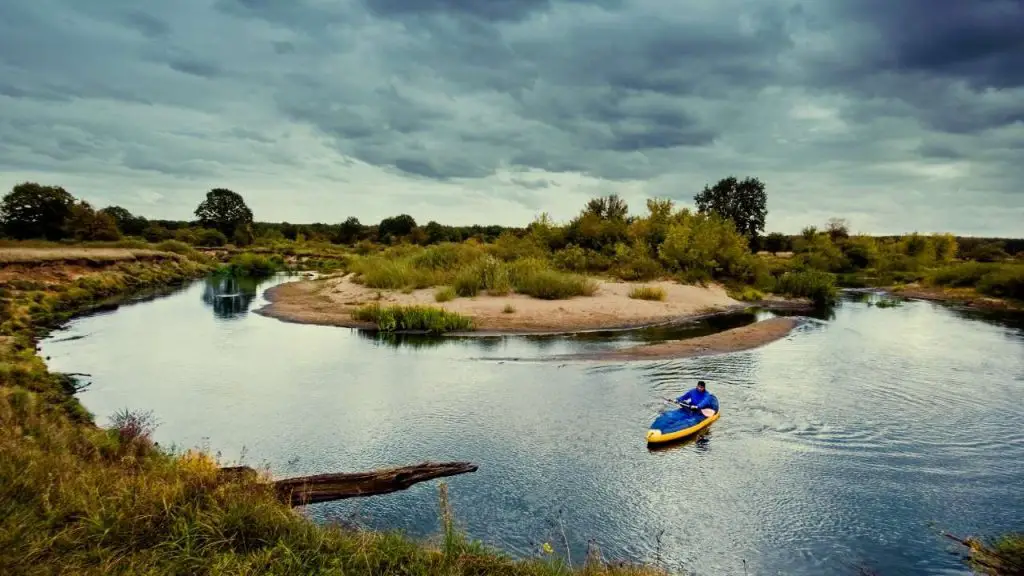
If you are kayaking and the weather suddenly changes, the best thing to do is to head for shore immediately.
If you are in the middle of a lake or river, try to paddle towards the nearest shoreline as quickly as possible.
Once you reach shore, take shelter in a nearby building or car.
Be sure to stay away from trees, as they could fall and injure you during a severe storm.
Also, be sure to monitor the weather conditions and only go back out once the storm has passed.
Remember not to paddle too far your car or house in order to stay safe during sudden weather changes.
If you can’t reach your car or house soon, you can ask a stranger for help or wait until the weather changes.
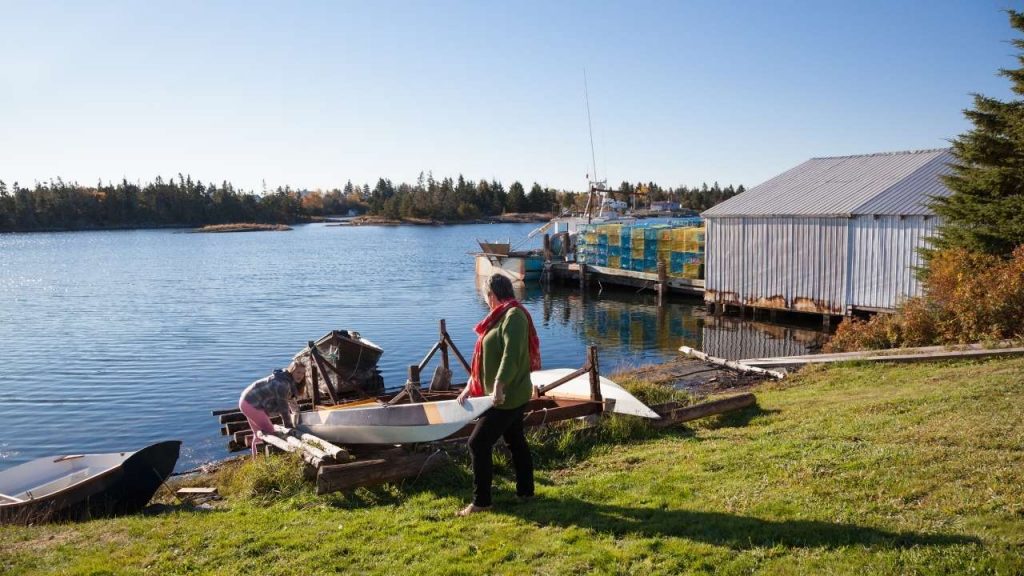
Sudden weather changes can be dangerous, so it’s always best to err on the side of caution and head for shore as soon as possible.
Paddling in Windy Conditions
Kayaking in windy conditions can be difficult for beginners, but it is not impossible.
If you must go out in windy weather, be sure to stay close to shore and avoid areas with large waves.
Also, be sure to keep your kayak pointed into the wind to make paddling easier. If the winds are too strong, you may need to get out of your kayak and walk it to shore.
Kayaking in Different Environments
Kayaking is a great way to explore different environments, but it is important to be aware of the dangers in each environment.
Lakes and rivers:
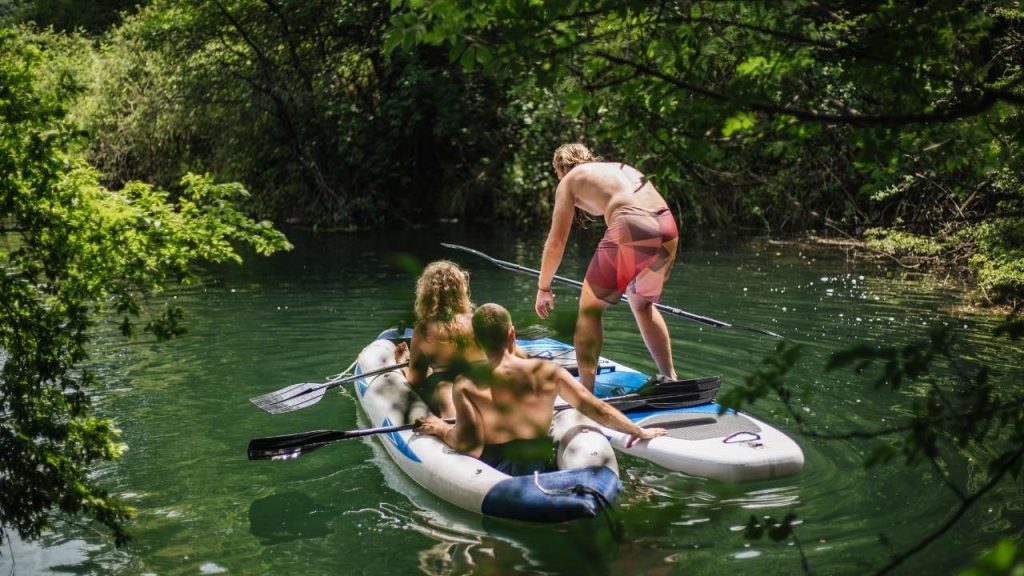
Lakes and rivers are generally safe for kayaking, but be sure to stay away from areas with large waves or currents. Also, be sure to dress warmly if it is cold outside and take extra blankets in case you get wet.
Coastal waters:
Coastal waters can be more dangerous than lakes and rivers because of the strong tides and waves.
Be sure to stay close to shore and avoid areas with large waves. Also, be sure to wear a life jacket and dress warmly if it is cold outside.
Wilderness areas:
Wilderness areas can be very dangerous because there are no nearby roads or buildings to take shelter in if the weather changes.
Be sure to stay on well-marked trails and be aware of your surroundings at all times. Also, be sure to dress warmly and take extra blankets in case you get wet.
FAQs
How Easy is it to Flip a Kayak?
It is relatively easy to flip a kayak, especially if you are a beginner. Strong winds can create waves and currents that make kayaking more difficult and even dangerous. Choppy, rough waters are also obviously not ideal for kayaking, and can pose a serious danger to beginners
What Should You Do If You Flip?
If you flip your kayak, the best thing to do is to head for shore immediately. If you are in the middle of a lake or river, try to paddle towards the nearest shoreline as quickly as possible. Once you reach shore, take shelter in a nearby building or car.

I am looking for a Windpaddle sail, in particular the Cruiser 52″ model. Is it available?